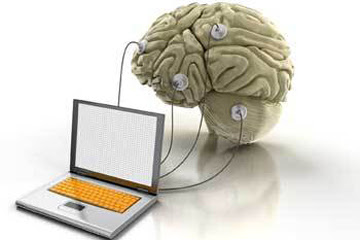Several tech billionaires are openly or secretely funding broadband mind computer interfacing projects
by noreply@blogger.com (brian wang) from NextBigFuture.com on (#2G6M1)
Last year Bryan Johnson, founder of the online payments company Braintree, starting making news when he threw $100 million behind Kernel, a startup he founded to enhance human intelligence by developing brain implants capable of linking people's thoughts to computers.
Johnson isn't alone in believing that "neurotechnology" could be the next big thing. To many in Silicon Valley, the brain looks like an unconquered frontier whose importance dwarfs any achievement made in computing or the Web.
According to neuroscientists, several figures from the tech sector are currently scouring labs across the U.S. for technology that might fuse human and artificial intelligence. In addition to Johnson, Elon Musk has been teasing a project called "neural lace," which he said at a 2016 conference will lead to "symbiosis with machines." And Mark Zuckerberg declared in 2015 that people will one day be able to share "full sensory and emotional experiences," not just photos. Facebook has been hiring neuroscientists for an undisclosed project at Building 8, its secretive hardware division.
Even when speaking to a computer program like Alexa or Siri, you can convey at most about 40 bits per second of information and only for short bursts. Compare that to data transfer records of a trillion bits per second along a fiber-optic cable.
"Ridiculously slow," Musk complained.

But it turns out that connecting to the brain isn't so easy. Six months after launching Kernel amid a media blitz, Johnson says he's dropped his initial plans for a "memory implant," switched scientific advisors, hired a new team, and decided to instead invest in developing a more general-purpose technology for recording and stimulating the brain using electrodes.
Johnson says he concluded that Berger's memory implant work "is really interesting, but not an entry point" into a commercially viable business.
DARPA says it is close to announcing $60 million in contracts under a program to create a "high-fidelity" brain interface able to simultaneously record from one million neurons (the current record is about 200) and stimulate 100,000 at a time.
Johnson declined to describe the specifics of Kernel's technological approach to connecting with the brain, as did Boyden and Wentz. However, the team members have been working on well-identified problems. Wentz has been involved with developing electronics for high-speed reading of data emitted by wireless implants. Already, the flow of information that can be collected from a mouse's brain in real time outruns what a laptop computer can handle. The team also needs a way to interface with the human brain. Boyden's lab has worked on several concepts to do so, including needle-shaped probes with tiny electrodes etched onto their surface. Another idea is to record neural activity by threading tiny optical fibers through the brain's capillaries, an idea roughly similar to Musk's neural lace.
Under a concept that Boyden calls "brain coprocessors," it may be possible to create closed-loop systems that detect certain brain signals-say, those associated with depression-and shock the brain to reverse them.
Read more










Johnson isn't alone in believing that "neurotechnology" could be the next big thing. To many in Silicon Valley, the brain looks like an unconquered frontier whose importance dwarfs any achievement made in computing or the Web.
According to neuroscientists, several figures from the tech sector are currently scouring labs across the U.S. for technology that might fuse human and artificial intelligence. In addition to Johnson, Elon Musk has been teasing a project called "neural lace," which he said at a 2016 conference will lead to "symbiosis with machines." And Mark Zuckerberg declared in 2015 that people will one day be able to share "full sensory and emotional experiences," not just photos. Facebook has been hiring neuroscientists for an undisclosed project at Building 8, its secretive hardware division.
Even when speaking to a computer program like Alexa or Siri, you can convey at most about 40 bits per second of information and only for short bursts. Compare that to data transfer records of a trillion bits per second along a fiber-optic cable.
"Ridiculously slow," Musk complained.

But it turns out that connecting to the brain isn't so easy. Six months after launching Kernel amid a media blitz, Johnson says he's dropped his initial plans for a "memory implant," switched scientific advisors, hired a new team, and decided to instead invest in developing a more general-purpose technology for recording and stimulating the brain using electrodes.
Johnson says he concluded that Berger's memory implant work "is really interesting, but not an entry point" into a commercially viable business.
DARPA says it is close to announcing $60 million in contracts under a program to create a "high-fidelity" brain interface able to simultaneously record from one million neurons (the current record is about 200) and stimulate 100,000 at a time.
Johnson declined to describe the specifics of Kernel's technological approach to connecting with the brain, as did Boyden and Wentz. However, the team members have been working on well-identified problems. Wentz has been involved with developing electronics for high-speed reading of data emitted by wireless implants. Already, the flow of information that can be collected from a mouse's brain in real time outruns what a laptop computer can handle. The team also needs a way to interface with the human brain. Boyden's lab has worked on several concepts to do so, including needle-shaped probes with tiny electrodes etched onto their surface. Another idea is to record neural activity by threading tiny optical fibers through the brain's capillaries, an idea roughly similar to Musk's neural lace.
Under a concept that Boyden calls "brain coprocessors," it may be possible to create closed-loop systems that detect certain brain signals-say, those associated with depression-and shock the brain to reverse them.
Read more